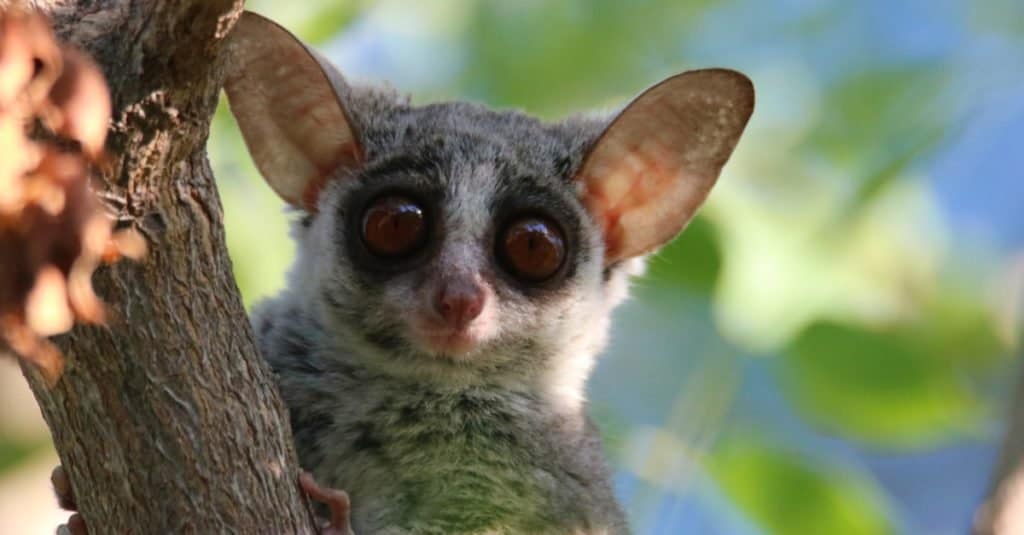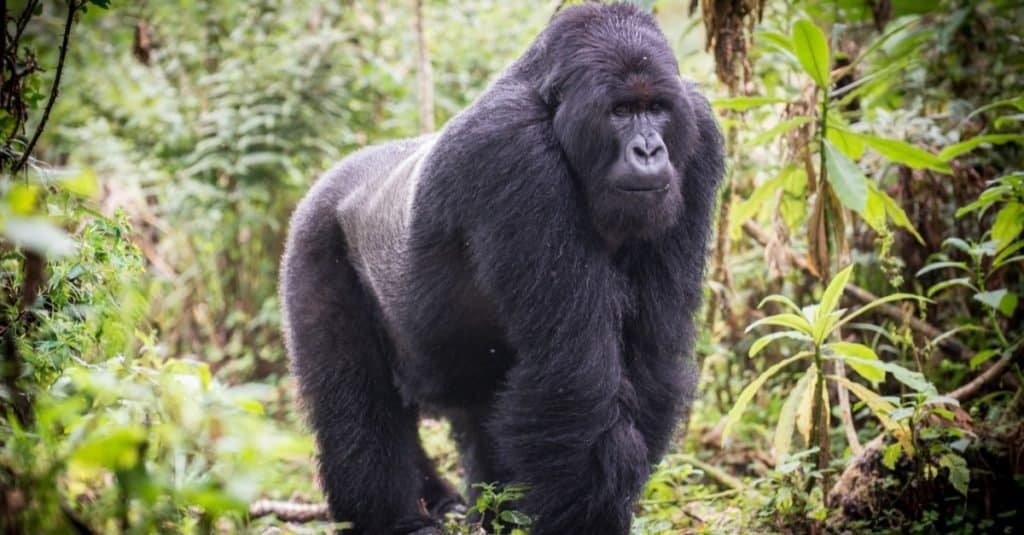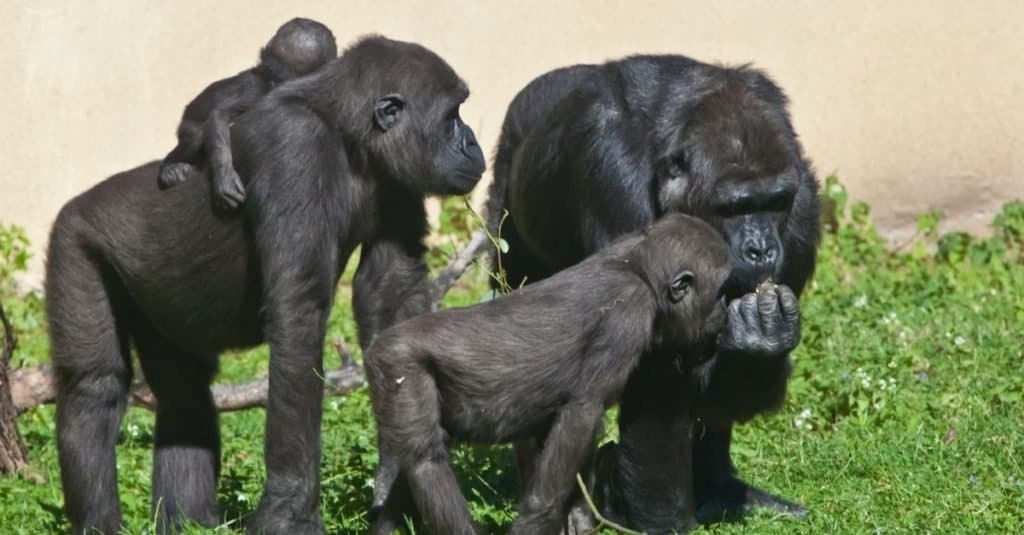Ape vs. Gorilla: The Main Differences Explained
@media (min-width: 481px) {
.mobile-top-content {
display: none;
}
}
#mobileTopContentCTACarouselControls { overflow: hidden; text-overflow: ellipsis; white-space: nowrap; }
.mobile-top-content .more { color: #fff; }
.mobile-top-content a { color: #fff; text-decoration: underline; }
.mobile-top-content a:hover { color: #fff; text-decoration: underline; }
@media (max-width: 480px) {
.mobile-top-content {
background-color: #06a10b;
color: #fff;
text-align: center;
/*height: 60px;
padding-top:5px;*/
font-size:80%;
/* display: block; */
margin: 0px -30px;
}
}
With terminology like “ape”, “great ape”, “monkey”, “primate”, and “gorilla” all meaning distinctly different things, it is hard to keep track of what’s what. In this article we’ll examine the key differences that distinguish other apes vs. gorillas.
There are so many levels of classification for different animals and different groupings that it can become very hard to understand. This article will clarify how primates are classified, specifically the gorilla. What does it mean to be a gorilla? What does it mean to be an ape? Let’s find out!
What is a primate?

Jurgens Potgieter/Shutterstock.com
A primate is an animal that belongs to the order Primates. This order includes all types of lemurs, lorises, tarsiers, monkeys, and apes, including humans and human ancestors. Some examples include ring-tailed lemurs, bush babies, chimpanzees, baboons, the aye aye, and hundreds more. Primates are therefore a very diverse population of related species.
Primates are distinct amongst mammals in several ways. Interestingly, they have larger brains relative to body size compared to other mammals. Most primates have opposable thumbs, and most primates have tails. Primates also have a greater reliance on their sense of vision than other mammals who rely more greatly on their sense of smell. Compared to other mammals, primates are also incredibly complex socially and are considered to be amongst the most social animals on the planet. They have longer developmental periods and have generally longer lifespans as well.
Ape vs. Gorilla: What is an ape?

Asaf Weizman/Shutterstock.com
Ape is a term for a group of primates belonging to the superfamily Hominoidea which includes chimpanzees, bonobos, orangutans, gorillas, gibbons, and humans. Within the superfamily Hominoidea is the family Hominidae which are colloquially known as the great apes. The great apes include chimpanzees, bonobos, orangutans, gorillas, and humans. The lesser apes, gibbons, belong to the family Hylobatidae.
Apes are distinct from other primates in a vast number of ways. The most notable differences include size, presence of a tail, geography, and intelligence. Apes are much larger than monkeys; the largest ape is the male gorilla weighing up to 500 pounds, whereas the largest monkey is the male mandrill weighing up to 119 pounds. Apes also do not have tails while most monkeys do. Geographically, apes in the wild are primarily isolated to Africa and Asia, whereas monkeys inhabit Africa, Asia, Central America, and South America. Apes are also some of the most intelligent animals in the world and have been studied extensively on matters of communication, problem solving, and tool use. More about the differences between monkeys and apes can be found here- Monkeys vs. Apes: The 5 Main Differences Explained.
Ape vs. Gorilla: What is a gorilla?

Jurgen Vogt/Shutterstock.com
Gorillas are the world’s largest primate and the world’s largest ape! They belong to the order Primates and the family Hominidae which means they are one of the great apes. Within that family, the genus Gorilla includes two species: Gorilla gorilla (western gorillas) and Gorilla beringei (eastern gorillas). Western gorillas are the most abundant species of gorilla and live in Angola, Cameroon, Central African Republic, the Democratic Republic of the Congo, Equatorial Guinea, and Gabon. The western gorilla is classified as critically endangered and has a total population of only 316,000 individuals. Eastern gorillas include the eastern lowland gorilla and the mountain gorilla. This species is also classified as critically endangered with only 880 mountain gorillas and 3,800 eastern lowland gorillas alive today. Eastern gorillas live in the Democratic Republic of the Congo, Uganda, and Rwanda.
Ape vs. Gorilla: The Main Differences Explained
The main differences between apes vs gorillas is that gorillas are a distinct genus within apes.
Compared to other apes, gorillas:
- Are larger than other apes. They weigh roughly five times the size of a bonobo and are more than twice the size of the largest orangutan. Male gorillas typically weigh between 300 and 500 pounds and females typically weigh between 150 and 250 pounds.
- Are closely related to humans, but not our closest relative. After chimpanzees and bonobos, gorillas are the next closest living relative to humans!
- Have opposable thumbs and lack a tail, which is in line with other apes including humans.
Gorillas are also very intelligent and very social animals capable of 25 distinct vocalizations. They typically live in a social system consisting of one dominant male and several females with their dependent offspring. Gorillas are documented in the wild using tools such as sticks and rocks to access food.
How are gorillas doing today?

Mikhail Semenov/Shutterstock.com
Both western gorillas and eastern gorillas are classified as critically endangered. This classification means the species are in immediate peril and near extinction. Habitat destruction, hunting, and disease threaten gorillas most. Gorilla poaching is common in the bushmeat trade in Africa despite legislation. The Gorilla Agreement is legislation prohibiting the hunting and trading of gorillas and was implemented in 2008. The countries where gorillas live, however, are not capable of effectively enforcing these laws, leaving gorillas still susceptible to hunting. Poachers, traders, and consumers of gorilla meat continue to profit from hunting these critically endangered animals.
Gorillas are also threatened by human disease because of how closely related they are to humans. An Ebola outbreak in the Democratic Republic of the Congo in 2004 killed several hundred gorillas in Odzala National Park. A 2006 study later estimated as many as 5,000 gorillas in central Africa were killed by the Ebola virus.
Efforts to counteract the decline of gorilla populations include captive breeding projects, ecological monitoring, and attempted legal measures. Conservation efforts in zoos have allowed for the successful breeding of approximately 4,000 western gorillas. Additionally, The Great Apes Survival Project (GRASP) established in 2001 aims to conserve non-human great apes including gorillas. GRASP has a particular emphasis on the conservation of the natural habitats of great apes and has taken steps to counteract habitat destruction.
More from A-Z Animals
.more-snake-card-image { max-height:140px !important; }
@media (min-width: 481px) {
.mobile-top-content {
display: none;
}
}
#mobileTopContentCTACarouselControls { overflow: hidden; text-overflow: ellipsis; white-space: nowrap; }
.mobile-top-content .more { color: #fff; }
.mobile-top-content a { color: #fff; text-decoration: underline; }
.mobile-top-content a:hover { color: #fff; text-decoration: underline; }
@media (max-width: 480px) {
.mobile-top-content {
background-color: #06a10b;
color: #fff;
text-align: center;
/*height: 60px;
padding-top:5px;*/
font-size:80%;
/* display: block; */
margin: 0px -30px;
}
}
With terminology like “ape”, “great ape”, “monkey”, “primate”, and “gorilla” all meaning distinctly different things, it is hard to keep track of what’s what. In this article we’ll examine the key differences that distinguish other apes vs. gorillas.
There are so many levels of classification for different animals and different groupings that it can become very hard to understand. This article will clarify how primates are classified, specifically the gorilla. What does it mean to be a gorilla? What does it mean to be an ape? Let’s find out!
What is a primate?

Jurgens Potgieter/Shutterstock.com
A primate is an animal that belongs to the order Primates. This order includes all types of lemurs, lorises, tarsiers, monkeys, and apes, including humans and human ancestors. Some examples include ring-tailed lemurs, bush babies, chimpanzees, baboons, the aye aye, and hundreds more. Primates are therefore a very diverse population of related species.
Primates are distinct amongst mammals in several ways. Interestingly, they have larger brains relative to body size compared to other mammals. Most primates have opposable thumbs, and most primates have tails. Primates also have a greater reliance on their sense of vision than other mammals who rely more greatly on their sense of smell. Compared to other mammals, primates are also incredibly complex socially and are considered to be amongst the most social animals on the planet. They have longer developmental periods and have generally longer lifespans as well.
Ape vs. Gorilla: What is an ape?

Asaf Weizman/Shutterstock.com
Ape is a term for a group of primates belonging to the superfamily Hominoidea which includes chimpanzees, bonobos, orangutans, gorillas, gibbons, and humans. Within the superfamily Hominoidea is the family Hominidae which are colloquially known as the great apes. The great apes include chimpanzees, bonobos, orangutans, gorillas, and humans. The lesser apes, gibbons, belong to the family Hylobatidae.
Apes are distinct from other primates in a vast number of ways. The most notable differences include size, presence of a tail, geography, and intelligence. Apes are much larger than monkeys; the largest ape is the male gorilla weighing up to 500 pounds, whereas the largest monkey is the male mandrill weighing up to 119 pounds. Apes also do not have tails while most monkeys do. Geographically, apes in the wild are primarily isolated to Africa and Asia, whereas monkeys inhabit Africa, Asia, Central America, and South America. Apes are also some of the most intelligent animals in the world and have been studied extensively on matters of communication, problem solving, and tool use. More about the differences between monkeys and apes can be found here- Monkeys vs. Apes: The 5 Main Differences Explained.
Ape vs. Gorilla: What is a gorilla?

Jurgen Vogt/Shutterstock.com
Gorillas are the world’s largest primate and the world’s largest ape! They belong to the order Primates and the family Hominidae which means they are one of the great apes. Within that family, the genus Gorilla includes two species: Gorilla gorilla (western gorillas) and Gorilla beringei (eastern gorillas). Western gorillas are the most abundant species of gorilla and live in Angola, Cameroon, Central African Republic, the Democratic Republic of the Congo, Equatorial Guinea, and Gabon. The western gorilla is classified as critically endangered and has a total population of only 316,000 individuals. Eastern gorillas include the eastern lowland gorilla and the mountain gorilla. This species is also classified as critically endangered with only 880 mountain gorillas and 3,800 eastern lowland gorillas alive today. Eastern gorillas live in the Democratic Republic of the Congo, Uganda, and Rwanda.
Ape vs. Gorilla: The Main Differences Explained
The main differences between apes vs gorillas is that gorillas are a distinct genus within apes.
Compared to other apes, gorillas:
- Are larger than other apes. They weigh roughly five times the size of a bonobo and are more than twice the size of the largest orangutan. Male gorillas typically weigh between 300 and 500 pounds and females typically weigh between 150 and 250 pounds.
- Are closely related to humans, but not our closest relative. After chimpanzees and bonobos, gorillas are the next closest living relative to humans!
- Have opposable thumbs and lack a tail, which is in line with other apes including humans.
Gorillas are also very intelligent and very social animals capable of 25 distinct vocalizations. They typically live in a social system consisting of one dominant male and several females with their dependent offspring. Gorillas are documented in the wild using tools such as sticks and rocks to access food.
How are gorillas doing today?

Mikhail Semenov/Shutterstock.com
Both western gorillas and eastern gorillas are classified as critically endangered. This classification means the species are in immediate peril and near extinction. Habitat destruction, hunting, and disease threaten gorillas most. Gorilla poaching is common in the bushmeat trade in Africa despite legislation. The Gorilla Agreement is legislation prohibiting the hunting and trading of gorillas and was implemented in 2008. The countries where gorillas live, however, are not capable of effectively enforcing these laws, leaving gorillas still susceptible to hunting. Poachers, traders, and consumers of gorilla meat continue to profit from hunting these critically endangered animals.
Gorillas are also threatened by human disease because of how closely related they are to humans. An Ebola outbreak in the Democratic Republic of the Congo in 2004 killed several hundred gorillas in Odzala National Park. A 2006 study later estimated as many as 5,000 gorillas in central Africa were killed by the Ebola virus.
Efforts to counteract the decline of gorilla populations include captive breeding projects, ecological monitoring, and attempted legal measures. Conservation efforts in zoos have allowed for the successful breeding of approximately 4,000 western gorillas. Additionally, The Great Apes Survival Project (GRASP) established in 2001 aims to conserve non-human great apes including gorillas. GRASP has a particular emphasis on the conservation of the natural habitats of great apes and has taken steps to counteract habitat destruction.






